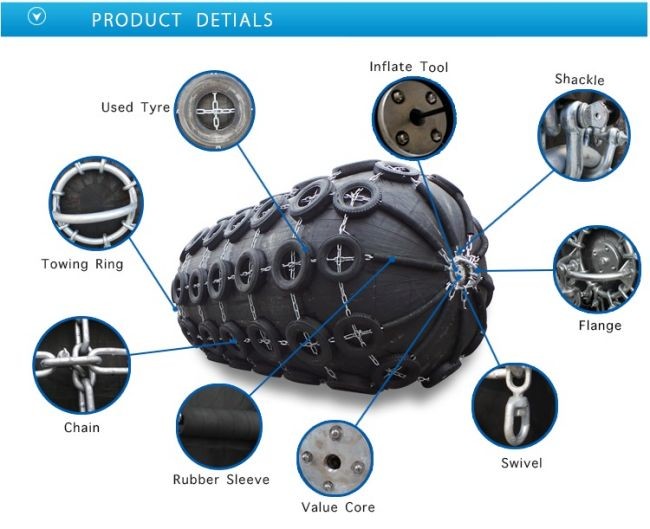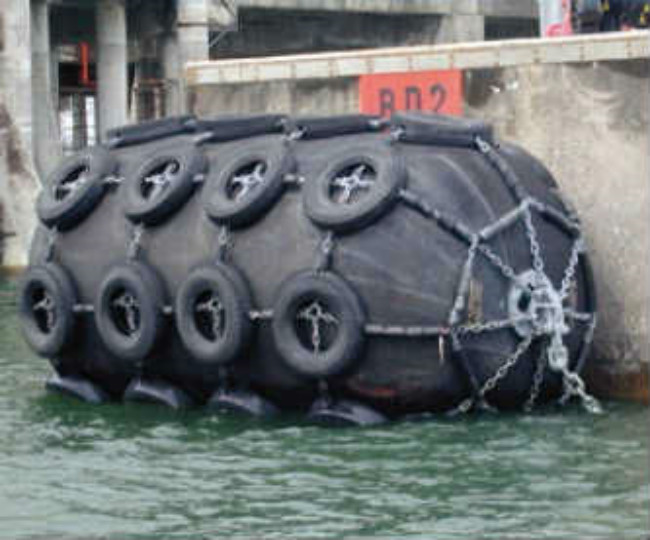QINGDAO SHUNHANG MARINE SUPPLIERS CO., LTD. |
|
Verified Suppliers
|
|
Professional Manufacturer Inflatable Marine Rubber Fenders
Product Introduction
Marine Rubber Fender is constructed of synthetic-cord-reinforced rubber sheets with compressed air inside to keep floating over the water surface and work as a shock absorber between two ships or between ships and berthing structure when they come alongside each other on the water.
Marine Rubber Fender is a leading anti-collision device for marine application in the world today. Pneumatic Fender has become an idea ship protection medium used extensively by large tankers, LPG vessels, ocean platforms, large docks, harbors and wharves.
Usually aircraft tires or truck tires are used toprotect the fender body. Both ends are equipped with shoulder straps, which are widely used for ship-to-ship transfer operations and ship berthing operations. Wait. The rubber Yokohama fenders are produced in strict accordance with ISO17357-2014 international quality standards, and the products are exported to all over the world.
Marine Rubber Fenders are suitable for many applications including:
1. Tankers, Gas Carries and Bulk Cargo Ships;
2. Fast ferries and aluminum hulled vessels;
3. Temporary of permanent installations;
4. Rapid response and emergency fendering;
5. As stand-off fenders to realign ships with shore facilities.
Specificaton of Marine Rubber Fender
| Size | Initial Internal Pressure 50kPa | Initial Internal Pressure 50kPa | |||
Diameter/ Meter | Length /Meter | Energy Absorption /KJ | Reaction Force /KN | Energy Absorption /KJ | Reaction Force /KN |
| 0.5 | 1 | 6 | 64 | 8 | 85 |
| 0.7 | 1.5 | 17 | 137 | 24 | 180 |
| 1.0 | 1.5 | 32 | 182 | 45 | 239 |
| 1.0 | 2.0 | 45 | 257 | 63 | 338 |
| 1.2 | 2.0 | 63 | 297 | 88 | 390 |
| 1.5 | 3.0 | 153 | 579 | 214 | 761 |
| 1.7 | 3.0 | 191 | 639 | 267 | 840 |
| 2.0 | 3.5 | 308 | 875 | 430 | 1150 |
| 2.5 | 4.0 | 663 | 1381 | 925 | 1815 |
| 2.5 | 5.5 | 943 | 2019 | 1317 | 2653 |
| 3.0 | 5.0 | 1050 | 2000 | 1571 | 2709 |
| 3.0 | 6.0 | 1312 | 2488 | 1888 | 3292 |
| 3.3 | 4.5 | 1175 | 1884 | 1640 | 2476 |
| 3.3 | 6.0 | 1675 | 2783 | 2338 | 3652 |
| 3.3 | 6.5 | 1814 | 3015 | 2532 | 3961 |

Advantage of Marine Rubber Fender
Advantages During Inclined Berthing
During berthing, the initial contact with the dock is usually at an oblique angle and that places a lot of pressure on both surfaces (the dock and the ship).
For typical solid rubber fenders, at inclined compression which is usually the case, energy absorption decreases considerably. Therefore, it is not unusual to see solid fenders used are larger in sizes. On the other hand, pneumatic fenders’ energy absorption maintains at a relatively high level despite inclined compression. Due to a more evenly distribution of load pressure, the torque performance against the dock is usually smaller when compared to conventionally designed solid fender systems.
Stronger Against Shearing Force
After making contact with the dock, the vessel is usually slowly moved to the optimum mooring position. This action exerts high shearing force and compression on the surface of fenders. Most solid fenders are severely damaged due to such forces as they are not designed to withstand strong shearing forces and friction that way. However, it depends on the designs/types of solid fenders. For example, MAX frontal pads for solid fenders are designed to tackle this issue and protect the fenders from shearing forces, in which the surface of fenders do not make contact with the ship.
Relatively Safe Even During Excess Load
Generally speaking, all fenders should be used within the impact load limit. However in real life situations, it is common to see that fenders often accidentally receive excess loads. When that happens, the fortunate thing about a pneumatic fender is that the reaction force does not increase sharply under excessive load. In contrast, solid fenders’ reaction forces tend to spike sharply under excessive load conditions and damage the ship during the mooring process. This is also helped by pneumatic type fenders’ characteristic that enables a more uniform distribution of stress.
Advantages During Crucial Weather Conditions
During crucial weather conditions when the wave action is severe, mooring processes are further complicated due to up and down unbalanced action at the quay. This exerts a higher shearing force on the fenders and the frequently change in forces during mooring under such weather conditions will cause fatigue on typical solid type fenders. However on the other hand, pneumatic fender’s flexible contact area and large allowable deflection characteristics minimise fatigue during such situations. In fact, for seas with rough situations or frequent bad weather conditions, pneumatic types may be a better option than solid type fenders as it may display a longer life span.
Deterioration in Performance Minimised
Aging and fatigue often cause fenders to deteriorate in terms of performance. However, due to its air filled body and highly elastic material, such issues are minimised. Solid rubber fenders or foam fenders depend more on the hardness of the material and such dependance may result in decrease in energy absorption performance after years of usage and temperature change. On the other hand, as long as basic maintenance and air pressure control is maintained, pneumatic fenders remain optimum performance even at extremely low temperature down to -50 Degree Celsius or even during high fluctuations.
Tide Adaptation
Pneumatic fenders are primarily floating-types, which means the fenders float on the water in an unrestricted vertical plane corresponding to the tidal range and ship’s vertical movement. Therefore, fender energy absorption always take place at the most optimum position.
Outer and Inner Rubber Material Requirements of Marine Rubber Fenders
Test item |
Test method | Required value | |
| Outer rubber | Inner rubber | ||
| 1. Before aging | – | – | – |
| 1.1 Tensile strength | ISO 37:2011 | 18 MPa or more | 10 MPa or more |
| 1.2 Elongation | ISO 37:2011 | 400 % or more | 400 % or more |
| 1.3 Hardness | ISO 7619-1:2010 | 60 ± 10 (Durometer hardness Type A) | 50 ± 10 (Durometer hardness Type A) |
2. After aging |
ISO 188:2011 | Air oven aging, 70°C ± 1°C, 96 h | Air oven aging, 70°C ± 1°C, 96 h |
| 2.1 Tensile strength | ISO 37:2011 | Not less than 80 % of the original property | Not less than 80 % of the origi- nal property |
| 2.2 Elongation | ISO 37:2011 | Not less than 80 % of the original property | Not less than 80 % of the origi- nal property |
| 2.3 Hardness | ISO 7619-1:2010 | Not to exceed the original prop- erty by more than 8 | Not to exceed the original prop- erty by more than 8 |
| 3. Tear | ISO 34-1:2010 | 400 N/cm or more | No requirement |
| 4. Compression set | ISO 815-1:2008 | 30 %(70 ± 1 °C, 22hours) or less | No requirement |
5. Static ozone aging test |
ISO 1431-1:2012 | No cracks after elongation by 20 % and exposure to 50 pphma at 40 °C for 96 h |
No requirement |
NOTE If the colour of the outer cover is not black, the material requirements will differ from those in this table. a Parts of ozone per hundred million of air by volume. | |||
Features of Marine Rubber Fender
1. Guaranteed energy absorption
2. Chain tyre net and sling type
3. Thick skin construction
4. Good angular performance
5. Less surface pressure onto the side wall of ships. (The capability of accepting surface pressure of the fender is up to 14 ton/m2).
6. No reduction on the performance of compression when inclined.
7. Suitable for areas with large or small tides.
8. Suitable in cold weather because the compressed air as buffering medium.
9. Especially in mooring of large scale ships in sea docks and lightering.
10. Maintains large clearances between hull and structure



FAQ:
Q1: What's your MOQ?
Answer: The MOQ of our marine rubber fender is 1pc.
Q2: What's the lifespan of your marine rubber fenders?
Answer: Designed lifespan of our marine rubber fenders is 6 to 10 years
Q3: What's your warranty period?
Answer: Our warranty period is 2 years. we will responsible for the repairment or replace the new ones for you if it proved to be our quality problem.
Q4: Can you suggest the suitable marine rubber fenders size and quantity for me?
Answer: Pls tell us your ship information, as experienced manufacturer, we can suggest suitable size and quantity for you.
Q5: What kind certificate you can provide.
Answer: BV, RS, ISO9001 etc.certificate is available